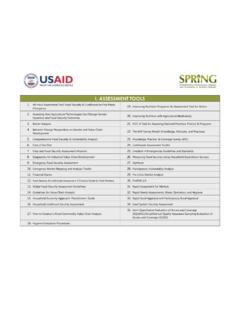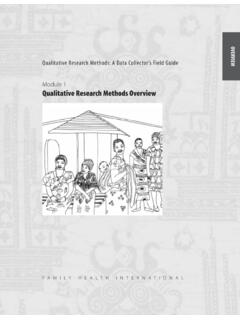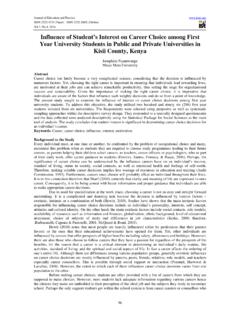Transcription of Lung cancer - World Health Organization
1 Lung cancerand Smoking ResearchGender inG e n d e rin Lung Cancerand Smoking ResearchDepartment of gender , Women and HealthFamily and Community Health World Health Organization 2005 All rights reserved. Publications of the World Health Organization can be obtained fromWHO Press, World Health Organization , 20 Avenue Appia, 1211 Geneva 27, Switzerland(tel: +41 22 791 2476; fax: +41 22 791 4857; email: Requestsfor permission to reproduce or translate WHO publications - whether for sale or for non-commercial distribution - should be addressed to WHO Press, at the above address(fax: +41 22 791 4806; email: designations employed and the presentation of the material in this publication donot imply the expression of any opinion whatsoever on the part of the World HealthOrganization concerning the legal status of any country, territory, city or area or of itsauthorities, or concerning the delimitation of its frontiers or boundaries.))
2 Dotted lines onmaps represent approximate border lines for which there may not yet be full mention of specific companies or of certain manufacturers' products does notimply that they are endorsed or recommended by the World Health Organization inpreference to others of a similar nature that are not mentioned. Errors and omissionsexcepted, the names of proprietary products are distinguished by initial capital reasonable precautions have been taken by WHO to verify the information con-tained in this publication. However, the published material is being distributed withoutwarranty of any kind, either express or implied. The responsibility for the interpreta-tion and use of the material lies with the reader.
3 In no event shall the World HealthOrganization be liable for damages arising from its named authors alone are responsible for the views expressed in this in ItalyGender in lung cancer and smoking researchWHO Library Cataloguing-in-Publication DataPayne, in lung cancer and smoking research / by Sarah Payne.( gender and Health research series) neoplasms epidemiology services identity factors 6. research 92 4 159252 4(NLM classification: W )ISSN 1813-2812iiiiiAcknowledgements1 Preface2 Abstract3 List of issues in lung cancer between women and men in lung cancerincidence, prevalence and mortality8 Differentials by geographical region11 Differentials in relation to social , gender and lung cancer : explaining thedifferences between men and women13 gender -linked factors14 Sex-linked issues in access to and cancer research : knowledge gaps andrecommendations for future challenges in lung cancer is required to address the knowledgegaps in lung cancer research ?
4 28 research methods and methodology28 Smoking and tobacco control29 Screening and treatment30 Sex and lung cancer risk: biological resources43 Contents1 AcknowledgmentsThis document was prepared for theWHO gender and Health ResearchSeries by Dr Sarah Payne, School forPolicy Studies, University of Bristol,Bristol, gender and Health ResearchSeries was developed by theDepartment of gender , Women andHealth (GWH), under the supervisionof Dr Claudia Garc a-Moreno andwith support from Dr Salma gratefully acknowledges thevaluable comments received from:Dr A Sasco and Dr K Straif from theInternational Agency for research onCancer, Lyon, France, Dr A Ullrichfrom the Programme on CancerControl (PCC) at WHO, and would liketo thank Ann Morgan for copy-editingthis WHO gender and Health ResearchS e r i e shas been developed by theDepartment of gender , Women andHealth (GWH), with assistance fromother WHO departments, in order toaddress some of the main issuesinvolved in integrating gender consider-ations into Health research .
5 This publi-cation on gender in Lung cancer andSmoking research constitutes one ofthe booklets in this and gender are both importantdeterminants of Health . Biological sexand socially-constructed gender inter-act to produce differential risks andvulnerability to ill Health , and differ-ences in Health -seeking behaviour andhealth outcomes for women and widespread recognition ofthese differences, Health research hashitherto, more often than not, failedto address both sex and gender applied Health research , includ-ing the social sciences, the problemhas traditionally been viewed as oneof rendering and interpreting sex dif-ferentials in data analysis and explor-ing the implications for policies andprogrammes.
6 However, examining thegender dimensions of a Health issueinvolves much more than this; itrequires unravelling how gender rolesand norms, differences in access toresources and power, and gender -based discrimination influence maleand female Health and gender considerationsin Health research contributes to bet-ter science and more focusedresearch, and, consequently, to moreeffective and efficient Health policiesand programmes. With these ambi-tions in mind, the objectives of thegender and research series are to:raise awareness of the need tointegrate gender in Health research ;provide practical guidance on howto do this; andidentify policies and mechanismsthat can contribute to engendering Health series is aimed at researchers, research coordinators, managers ofresearch institutions, and researchfunding agencies.
7 It comprises book-lets covering both a general introduc-tion to engendering the researchprocess as well as topic-specificissues such as lung cancer , tuberculo-sis, and mental Health . The researchseries will be extended to other healthtopics in booklet will review the partic-ular Health issue from a gender per-spective, identify best practices inaddressing gender in research and thegaps in gendered research , and makerecommendations to address paper reviews the need for a gen-der- sensitive approach to lung cancerresearch. Lung cancer is a majorcause of premature and avoidablemortality around the World , andalthough in more developed countriesmortality rates are beginning todecrease, especially in men, the num-ber of deaths from lung cancer in lessdeveloped countries is steadilyincreasing.
8 While historically moremen than women have died from lungcancer as a result of higher levels ofsmoking, the male:female mortalityratio is now showing signs of narrow-ing. Both sex- and gender -linked fac-tors are important in the etiology oflung cancer . However, research intolung cancer needs to address gendermore specifically if we are to makeprogress in reducing both the majorrisk factor tobacco use and thenumber of deaths from this paper reviews what is currentlyknown about sex and gender influ-ences on lung cancer , identifies cur-rent gaps in gender research on lungcancer and smoking and suggestssome directions for the Medical AssociationBMIBody mass indexCDCC enters for Disease Control and PreventionCOPDC hronic obstructive pulmonary diseaseCTComputed TomographyETSE nvironmental tobacco smokeHRTH ormone replacement therapyIARCI nternational Agency for research on CancerRCTR andomized control trialUSDHHSU nited States Department of Health and Human SciencesList of abreviations5 The "epidemic" of lung cancer mortal-ity has been identified as a majorhealth issue confronting both devel-oped and developing countries.
9 In2000, over one million people diedfrom lung cancer worldwide; 53% ofthese deaths occurred in the moredeveloped countries, the remaining47% in the less developed countries(GLOBOCAN, 2000). Overall, womenaccounted for just over a quarter of alllung cancer deaths. Estimates sug-gest that by 2030, all tobacco-relatedmortality, including lung cancer , willreach around 10 million deaths peryear, with the greatest increase com-ing from the less developed countries(Jha et al., 2002).Although available data clearlydemonstrates differing trends in lungcancer mortality for men and women,it is only in the last few years thatthere has been an increased aware-ness of the differences in lung cancerrisk associated with both sex ( bio-logical factors) and gender or socially-constructed factors (see Box 1, nextpage).
10 Despite the growing body ofresearch which explores the ways inwhich different patterns of lung can-cer incidence, mortality and survivalmight be associated with sex andgender, uncertainties about a numberof aspects of the disease and how itdiffers for men and women remain. Atpresent, many of the research find-ings in this particular field are sugges-tive rather than established. Thisuncertainty reflects, at least in part,the complexity of the factors involved we must think not only of the rolesplayed by sex and biology, and bygender-related issues, such as accessto resources, sexual division of labourand Health -seeking behaviour, butalso how these factors interact. Forexample, lung cancer is highly associ-ated with tobacco consumption, butalso occurs in those who have neversmoked.



















